The Impact of Pollution on Non-Small Cell Lung Cancer: Unveiling the Connection

The prevalence of non-small cell lung cancer (NSCLC) continues to be a significant public health concern, with environmental factors playing a pivotal role in its development and progression. Among these factors, pollution, in its various forms, has emerged as a substantial contributor to the rising incidence of NSCLC. Understanding the intricate relationship between pollution and NSCLC is paramount in addressing this pressing health issue.
Unveiling the Link between Pollution and Non-Small Cell Lung Cancer:
Particulate Matter and Air Pollution:
Air pollution, particularly fine particulate matter (PM2.5) consisting of tiny particles suspended in the air, has been closely associated with an increased risk of NSCLC. Prolonged exposure to high levels of PM2.5, often stemming from vehicle emissions, industrial activities, and agricultural practices, has been linked to the development of lung cancer, including NSCLC. These fine particles can penetrate deep into the lungs, leading to inflammation, oxidative stress, and DNA damage, thereby fostering an environment conducive to cancer initiation and progression.
Chemical Carcinogens:
Exposure to carcinogenic compounds present in polluted air, such as polycyclic aromatic hydrocarbons (PAHs), benzene, and formaldehyde, can significantly elevate the risk of NSCLC. These hazardous substances, often produced by vehicular exhaust, industrial emissions, and other sources, have been identified as potent contributors to lung cancer development. Upon inhalation, these carcinogens can interact with lung tissues, triggering molecular changes that may ultimately lead to the onset of NSCLC.
Indoor Air Quality and Radon Exposure:
Indoor air pollution, encompassing elements such as tobacco smoke, radon, and indoor combustion byproducts, represents an additional facet of the pollution-NSCLC correlation. Radon, a radioactive gas naturally occurring in soil and rock, is a significant indoor air pollutant linked to lung cancer, including NSCLC. Prolonged exposure to elevated radon levels in poorly ventilated buildings or homes can substantially heighten the risk of developing NSCLC, making indoor air quality a critical consideration in lung cancer prevention.
Cumulative Impact of Pollution:
Furthermore, the cumulative impact of various sources of pollution, including occupational exposures, secondhand smoke, and environmental toxins, must be acknowledged in understanding the broad influence of pollution on NSCLC. The convergence of these diverse pollutants, both outdoor and indoor, can synergistically contribute to the development and aggravation of NSCLC, underscoring the need for holistic approaches to mitigate pollution-related lung cancer risks.
Addressing the Challenge: Mitigating Pollution-Associated Risks for NSCLC:
Recognizing the profound impact of pollution on NSCLC, concerted efforts are essential to mitigate these risks and foster a healthier, cleaner environment for all. This includes:
- Stringent Pollution Control Measures: Implementing and enforcing robust regulations to control air and water pollution from industrial, vehicular, and other sources is imperative. Addressing emissions, minimizing industrial pollutants, and promoting cleaner energy alternatives are vital steps in reducing pollution-associated cancer risks.
- Promotion of Clean Energy Solutions: Embracing renewable energy sources, promoting electric vehicles, and transitioning away from fossil fuel-based energy generation are transformative avenues to curtail air pollution and its detrimental effects on lung health.
- Awareness and Advocacy: Raising awareness about the link between pollution and NSCLC, advocating for clean air initiatives, and empowering communities to take proactive measures to reduce pollution exposure is crucial in fostering a culture of environmental stewardship and public health.
Read More from our latest study on Non-Small Cell Lung Cancer Market and its Treatment Types, Distribution Channel, Payers in the market.
Conclusion:
The impact of pollution on non-small cell lung cancer is a multifaceted and pressing challenge that necessitates comprehensive strategies spanning environmental, public health, and policy domains. By addressing pollution at its roots, promoting clean energy solutions, and fostering public awareness, we can take proactive steps to mitigate the substantial risks posed by pollution to lung health. Through collective action and dedication to safeguarding the environment, we can strive towards a future where pollution-related lung cancer risks are minimized, and the well-being of individuals is safeguarded.
– Analyst Team
IHR Insights
inquiry@ihrinsights.com

